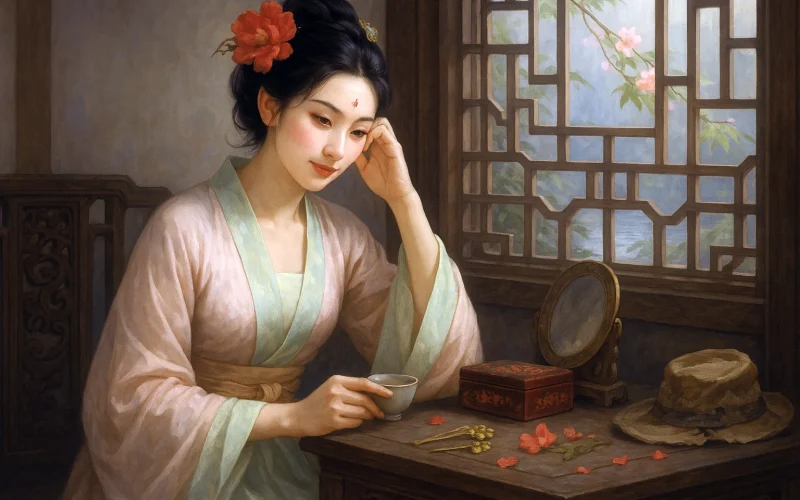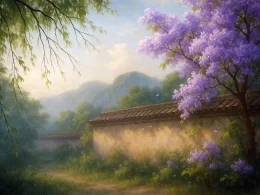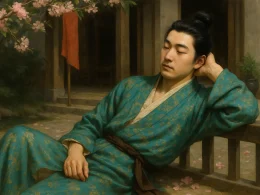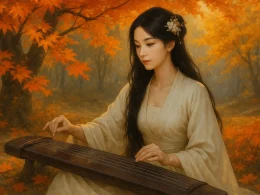She slams the jade compact—done with their gaze,
A rebel branch flames at her ear's maze.
That calculated pout, that strategic smile,
Now spring silk hugs her like a conspiratorial style.
Nature's couture: gold slashed, jade spliced,
Not for those straw-cap monks, morally iced.
She crowns herself with riotous blooms,
Ten patriarchal years shed in one costume.
Original Poem
「玉楼春 · 玉奁收起新妆了」
周邦彦
玉奁收起新妆了。鬓畔斜枝红袅袅。
浅颦轻笑百般宜,试著春衫犹更好。
裁金簇翠天机巧。不称野人簪破帽。
满头聊插片时狂,顿减十年尘土貌。
Interpretation
This ci poem, composed by Zhou Bangyan of the Song Dynasty to the musical mode "Dashidiao," exemplifies his mastery of lyrical musicality and refined scene-painting. While its exact date remains uncertain, the work's mature craftsmanship displays Zhou's signature style—exquisite elegance tinged with wistfulness. Through delicate depictions of a woman's springtime toilette, the poem captures both nature's seasonal vitality and feminine self-possession, blending aesthetic observation with psychological insight.
First Stanza: "玉奁收起新妆了。鬓畔斜枝红袅袅。"
Yù lián shōu qǐ xīn zhuāng liǎo. Bìn pàn xié zhī hóng niǎo niǎo.
The jade vanity case closes—her fresh toilette complete;
by her temples, crimson branches sway on delicate stems.
The opening juxtaposes containment and movement—the closed "jade vanity case" (玉奁) signaling finished preparation, while the "swaying crimson branches" (红袅袅) at her temples introduce dynamic grace. The "branches" likely refer to floral hairpins, their motion mirroring both spring's vitality and the wearer's restrained animation. Zhou's choice of "jade" for the cosmetic case elevates mundane ritual into aesthetic ceremony.
Second Stanza: "浅颦轻笑百般宜,试著春衫犹更好。"
Qiǎn pín qīng xiào bǎi bān yí, shì zhuó chūn shān yóu gèng hǎo.
A faint frown, soft laughter—each expression suits;
trying on spring robes enhances her charm further still.
Here Zhou choreographs micro-expressions into a portrait of unstudied elegance. The "faint frown" (浅颦) and "soft laughter" (轻笑) suggest natural charisma rather than performative charm, while the donning of spring attire becomes a sartorial blossoming that complements both season and wearer. The stanza embodies the Confucian ideal of harmonious self-cultivation—where inner grace and outward presentation achieve perfect congruence.
Third Stanza: "裁金簇翠天机巧。不称野人簪破帽。"
Cái jīn cù cuì tiān jī qiǎo. Bù chèn yě rén zān pò mào.
Gold-cut and jade-clustered, wrought with celestial craft—
such ornaments ill suit a rustic's tattered hat.
The focus shifts to sartorial semiotics. The "gold-cut and jade-clustered" (裁金簇翠) adornments represent not just material luxury but divine artistry ("celestial craft"), while their incompatibility with a "rustic's hat" (野人簪) establishes social distinction through aesthetic contrast. Zhou subtly critiques vulgarity by highlighting refinement's inherent exclusivity.
Fourth Stanza: "满头聊插片时狂,顿减十年尘土貌。"
Mǎn tóu liáo chā piàn shí kuáng, dùn jiǎn shí nián chén tǔ mào.
Momentary madness—her coiffure now blooms riotously,
erasing ten years of worldly wear at a stroke.
The conclusion unveils the poem's emotional core. The "momentary madness" (片时狂) of elaborate hair ornaments becomes an act of transformative rebellion against time's erosion. Where cosmetics initially concealed, this sartorial exuberance actively reverses aging's traces ("erasing ten years"), suggesting that true beauty resides in audacious self-affirmation rather than timid conformity.
Holistic Appreciation
Zhou constructs a four-act drama of feminine self-fashioning: preparation (stanza one), presentation (two), ornamentation (three), and transcendence (four). Each stanza advances the ritual chronologically while deepening its symbolic resonance—from the jade case's closure to the floral hairpins' motion, from expressive nuances to sartorial statements, culminating in the cathartic "erasure" of time's marks.
The poem's brilliance lies in its dual focus: meticulously recording material details (cosmetics, fabrics, jewels) while revealing their psychological impact. The woman's toilette becomes alchemical process—base materials (cloth, metal, flowers) transmuted into spiritual armor against mortality. Zhou implies that beauty, properly understood, is not vanity but resistance—a willful assertion of vitality against entropy's inevitability.
Artistic Merits
- Kinetic still life
The "swaying crimson branches" inject movement into portraiture, blending Dutch still-life precision with Impressionist vibrancy. - Sartorial symbolism
Spring robes and jeweled hairpins operate as seasonal and social signifiers, compressing complex cultural codes into concise imagery. - Chronological alchemy
The "ten years erased" conceit transforms cosmetics from superficial cover to temporal manipulation, anticipating Shakespearean "time's tyranny" themes. - Social contrast
The rustic's hat versus refined ornaments crystallizes Song dynasty class aesthetics through sartorial antithesis.
Insights
Zhou's poem reveals premodern China's sophisticated understanding of beauty as performative self-creation rather than passive endowment. The woman's "momentary madness" demonstrates how calculated excess can achieve spiritual purification—an idea resonating with modern "power dressing" psychology.
For contemporary readers, the work challenges binary notions of natural versus artificial beauty. Zhou's subject derives empowerment equally from innate expressiveness ("faint frown, soft laughter") and crafted adornment ("gold-cut and jade-clustered"), suggesting true elegance harmonizes inherent grace with intentional enhancement.
Ultimately, the poem posits that self-fashioning is existential statement—when the woman "erases ten years of worldly wear," she doesn't deny time's passage but reclaims agency over its visible effects. In an era obsessed with anti-aging, Zhou's insight remains startlingly relevant: that beauty's deepest power lies not in appearing timeless, but in momentarily bending time to one's will.
About the Poet
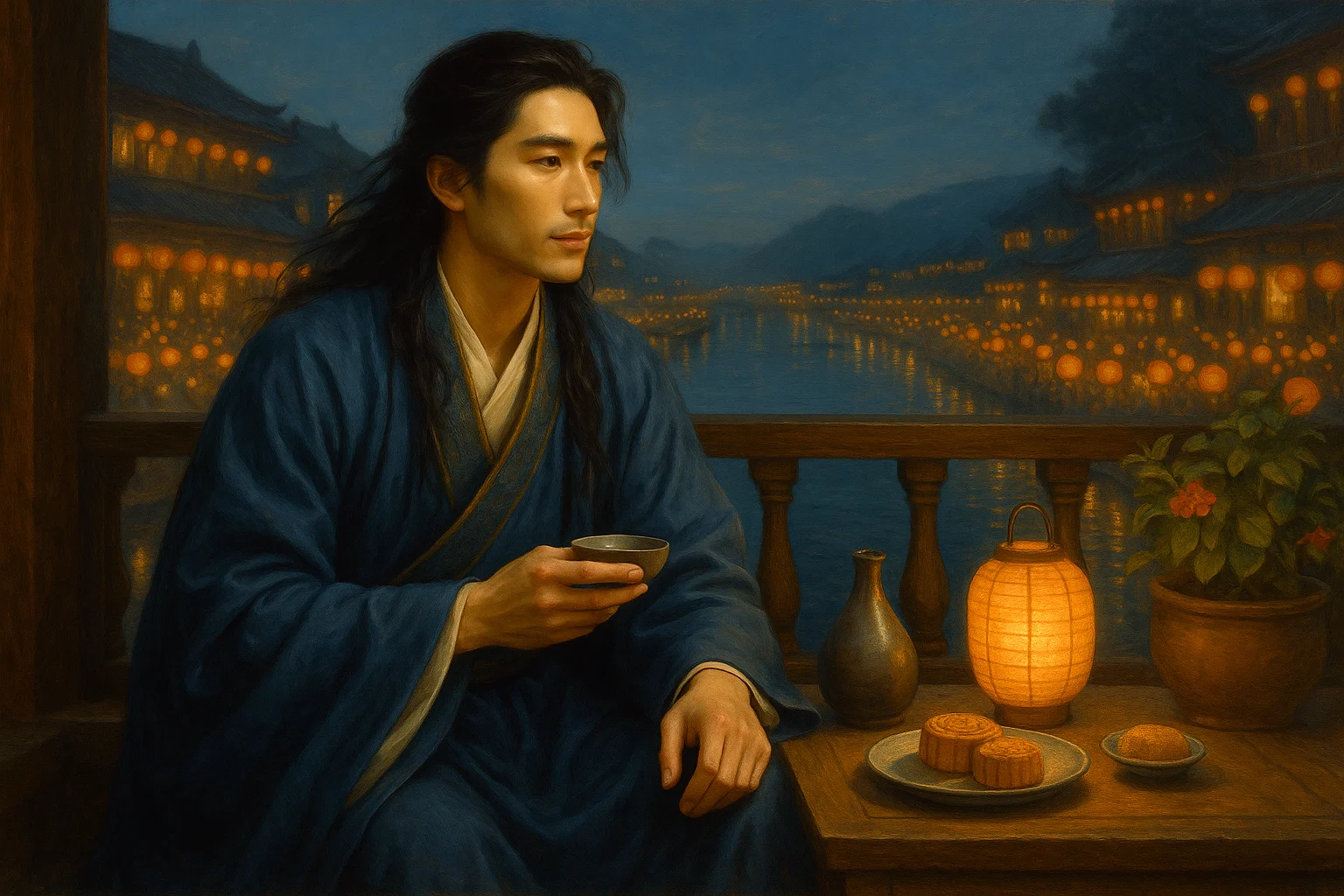
Zhou Bangyan (周邦彦 1056 - 1121), a native of Qiantang (modern Hangzhou, Zhejiang), was the culminating master of the wanyue (graceful and restrained) ci poetry of the Northern Song Dynasty. A virtuoso in musical temperament, his ci are renowned for their opulent refinement and technical perfection. He created dozens of new melodic patterns (cipai) and adhered to strict tonal rules, earning him the title "Crown of Ci Poets." His influence extended to Southern Song masters like Jiang Kui and Wu Wenying, establishing him as the founding patriarch of the Rhymed Ci School.






